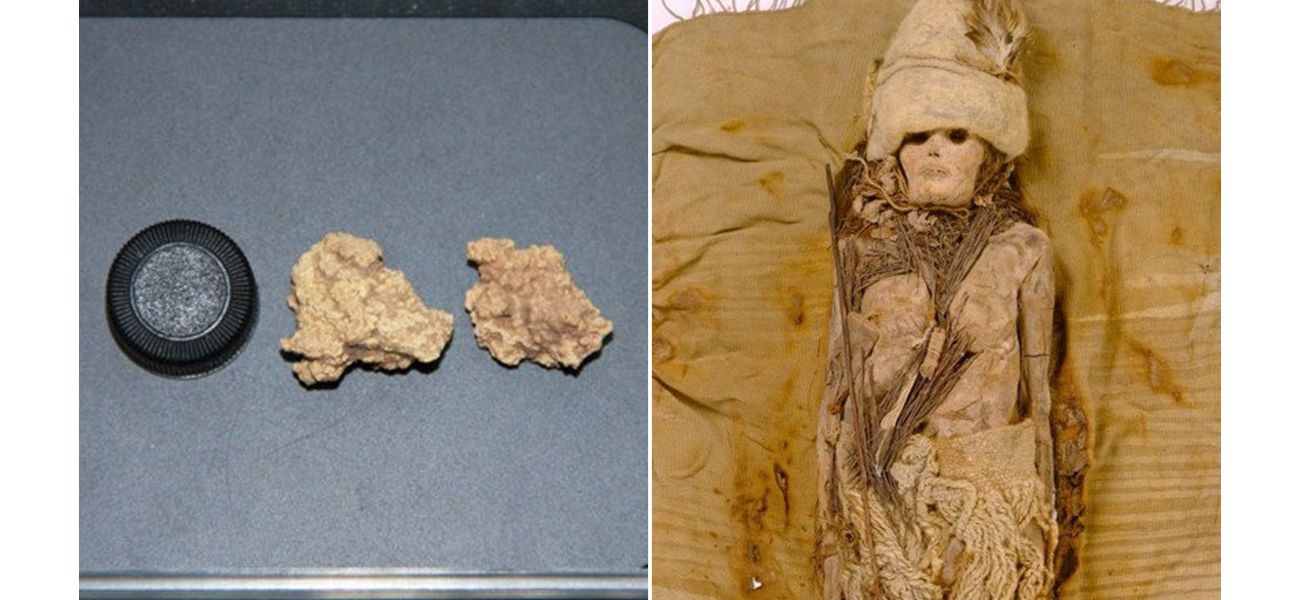Ancient cheese found in unexpected location after 3,600 years.
Oldest cheese sample discovered in the world.
September 30th 2024.

In a surprising discovery, scientists have unearthed the world's oldest cheese, dating back a remarkable 3,600 years. This delectable find was not in a fancy cheese shop or a grand palace, but rather in a cemetery in China, where it was stored alongside ancient mummies from the Bronze Age. After thorough analysis, they have determined that this cheese is actually kefir, a type of fermented dairy product.
The findings, which were recently published in the journal Cell, provide new insight into the origins of kefir cheese and the evolution of probiotic bacteria. Lead researcher Professor Qiaomei Fu, from the Chinese Academy of Sciences, explains the significance of this discovery: "This is the oldest known cheese sample ever discovered in the world. Food items like cheese are incredibly difficult to preserve over such a long period of time, making this a rare and valuable opportunity. By studying this ancient cheese, we can gain a better understanding of our ancestors' diet and culture."
Professor Fu and her team were able to analyze the milk proteins in the cheese, thanks to advancements in ancient DNA analysis. The cheese was found smeared on the heads and necks of several mummies in the Xiaohe cemetery in China's Tarim Basin. These mummies, which date back to 3,300 to 3,600 years ago, had been discovered about 20 years ago by archaeologists. At the time, researchers believed the white substances on the mummies may have been a type of fermented dairy product, but they were unable to determine its exact origin.
Now, with the help of mitochondrial DNA analysis, the team has confirmed that the white substances were indeed kefir cheese. They were also able to identify cow and goat DNA in the cheese samples. Professor Fu explains that the ancient Xiaohe people used different types of animal milk in separate batches, a practice that differs from the mixing of milk types commonly seen in Middle Eastern and Greek cheesemaking.
But the discoveries didn't stop there. The researchers were also able to extract DNA from microorganisms found in the dairy samples. They found bacterial and fungal species, including Lactobacillus kefiranofaciens and Pichia kudriavzevii, which are still commonly found in present-day kefir grains. These grains contain multiple species of probiotic bacteria and yeast, which ferment milk into kefir cheese, similar to a sourdough starter.
By sequencing the bacterial genes in the ancient kefir cheese, the researchers were able to track how probiotic bacteria has evolved over the past 3,600 years. They compared the ancient Lactobacillus kefiranofaciens to the modern-day species and found that there are now two major groups of this bacteria. One originated in Russia and the other in Tibet. The Russian type is the most widely used globally, including in Europe, the United States, and Japan for making yogurt and cheese.
Professor Fu is excited about the possibilities this technology presents for further exploration into ancient artifacts. She says, "This is just the beginning, and with this technology, we hope to explore other previously unknown objects. By examining dairy products, we can gain a clearer picture of ancient human life and their interactions with the world." Thanks to this groundbreaking research, we can now add cheese to the long list of things that connect us to our ancestors from thousands of years ago.
The findings, which were recently published in the journal Cell, provide new insight into the origins of kefir cheese and the evolution of probiotic bacteria. Lead researcher Professor Qiaomei Fu, from the Chinese Academy of Sciences, explains the significance of this discovery: "This is the oldest known cheese sample ever discovered in the world. Food items like cheese are incredibly difficult to preserve over such a long period of time, making this a rare and valuable opportunity. By studying this ancient cheese, we can gain a better understanding of our ancestors' diet and culture."
Professor Fu and her team were able to analyze the milk proteins in the cheese, thanks to advancements in ancient DNA analysis. The cheese was found smeared on the heads and necks of several mummies in the Xiaohe cemetery in China's Tarim Basin. These mummies, which date back to 3,300 to 3,600 years ago, had been discovered about 20 years ago by archaeologists. At the time, researchers believed the white substances on the mummies may have been a type of fermented dairy product, but they were unable to determine its exact origin.
Now, with the help of mitochondrial DNA analysis, the team has confirmed that the white substances were indeed kefir cheese. They were also able to identify cow and goat DNA in the cheese samples. Professor Fu explains that the ancient Xiaohe people used different types of animal milk in separate batches, a practice that differs from the mixing of milk types commonly seen in Middle Eastern and Greek cheesemaking.
But the discoveries didn't stop there. The researchers were also able to extract DNA from microorganisms found in the dairy samples. They found bacterial and fungal species, including Lactobacillus kefiranofaciens and Pichia kudriavzevii, which are still commonly found in present-day kefir grains. These grains contain multiple species of probiotic bacteria and yeast, which ferment milk into kefir cheese, similar to a sourdough starter.
By sequencing the bacterial genes in the ancient kefir cheese, the researchers were able to track how probiotic bacteria has evolved over the past 3,600 years. They compared the ancient Lactobacillus kefiranofaciens to the modern-day species and found that there are now two major groups of this bacteria. One originated in Russia and the other in Tibet. The Russian type is the most widely used globally, including in Europe, the United States, and Japan for making yogurt and cheese.
Professor Fu is excited about the possibilities this technology presents for further exploration into ancient artifacts. She says, "This is just the beginning, and with this technology, we hope to explore other previously unknown objects. By examining dairy products, we can gain a clearer picture of ancient human life and their interactions with the world." Thanks to this groundbreaking research, we can now add cheese to the long list of things that connect us to our ancestors from thousands of years ago.
[This article has been trending online recently and has been generated with AI. Your feed is customized.]
[Generative AI is experimental.]
0
0
Submit Comment





